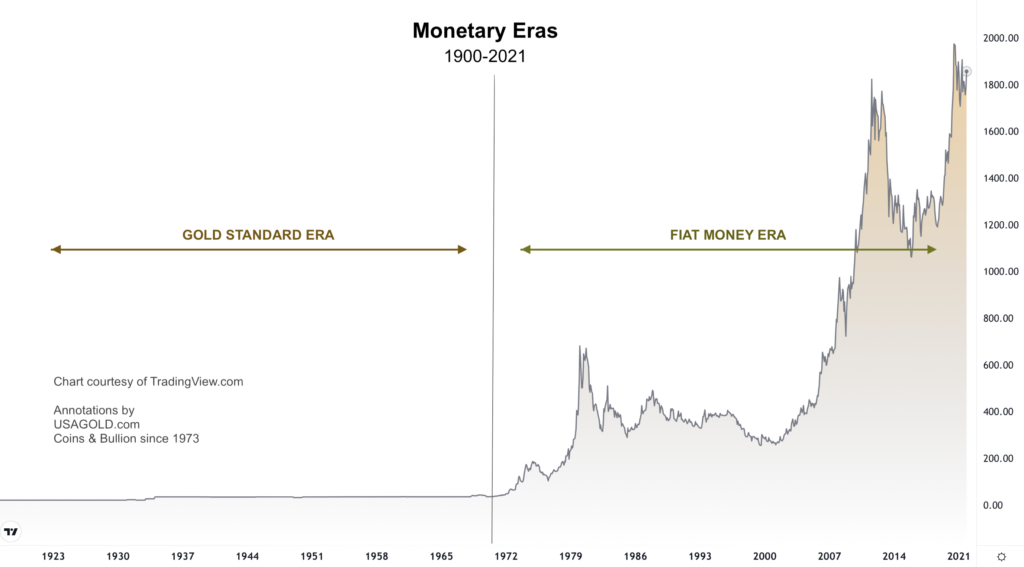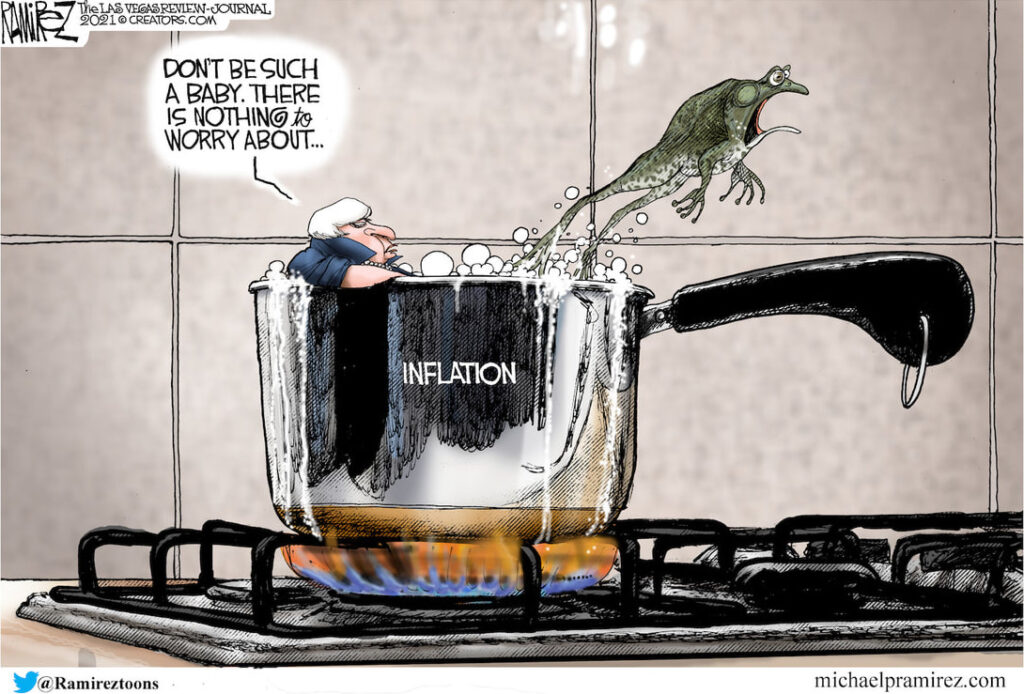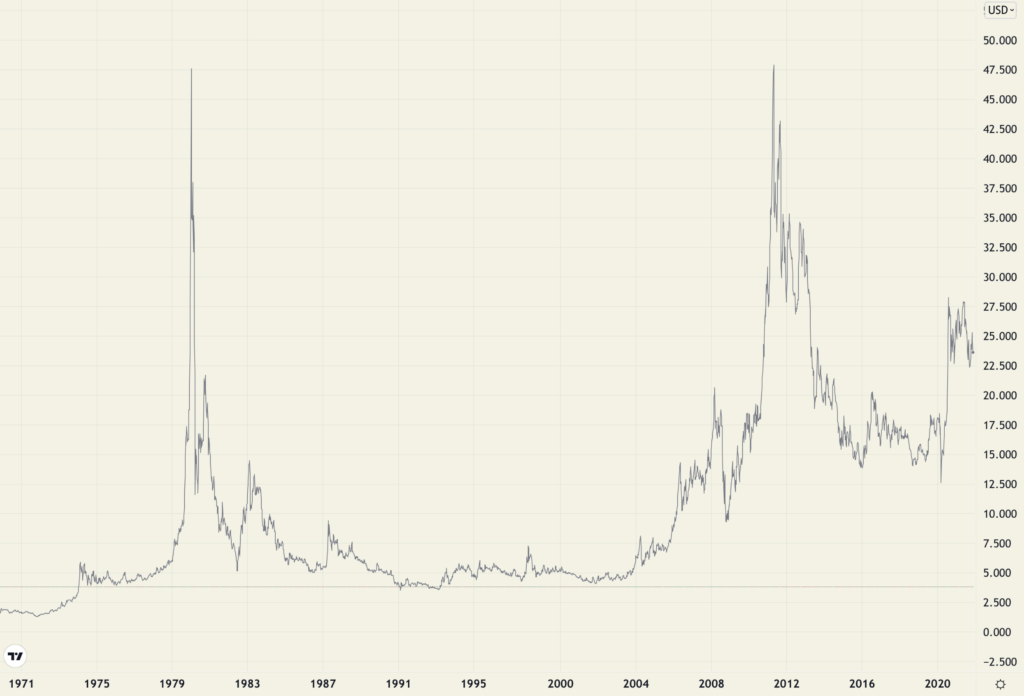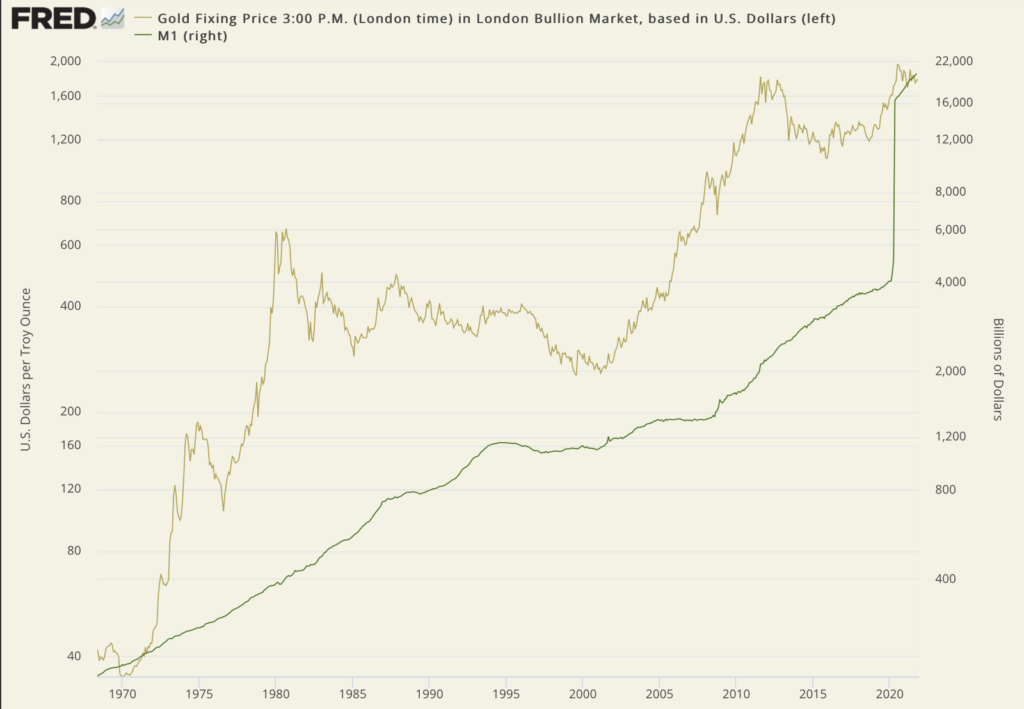NEWS &VIEWS
Forecasts, Commentary & Analysis on the Economy and Precious Metals
Celebrating our 48th year in the gold business
December 2021
“On Wall Street he and a few others – how many? three hundred, four hundred, five hundred? had become precisely that… Masters of the Universe.” – Tom Wolfe, Bonfire of the Vanities
––––––––––––––––––––––––––––––––––––––––––––––––––––––––––––
The Masters of the Universe and Gold
‘A bond issued by God’

That small group of investment bankers – those Tom Wolfe dubbed the Masters of the Universe – made its fortune trading U.S. Treasuries. That group still plays the same role today that it always has, but it no longer occupies the center stage for Wall Street’s bond market. Instead, that role now belongs to the Federal Reserve. Since the introduction of quantitative easing in 2008, it has built a $5.57 trillion stockpile of U.S. Treasuries – a holding equal to almost 20% of the nearly $29 trillion national debt. Even more troubling, it purchased a mind-boggling 60% to 80% of the federal debt issued since 2010, according to a recent Wall Street Journal report.
“At 10:10 a.m. most workdays on Wall Street,” writes Liz McCormick in a recent Bloomberg column (under the unsettling headline, One Trader Calls the Shots in the Treasury Bond Market) officials at the Federal Reserve wade into the Treasury bond market. For the next 20 minutes, they proceed to snap up bonds of all shapes and sizes. They’re impervious to price moves, and they never sell. An indiscriminate bond-buying machine, they’ve now amassed a $5.5 trillion stockpile of the debt.” Wolfe’s Masters of the Universe have been replaced by one omnipresent, spectacularly powerful, and as it turns out, fickle Master of the Universe – America’s central bank.
“For almost two years,” says Gillian Tett, in a recent Financial Times editorial, “a frightening question has haunted the U.S. Treasury and Federal Reserve. No, this is not whether the Fed can engineer a smooth exit from quantitative easing; nor whether this is the right moment to switch the governor (and policy). The question I am referring to is whether the U.S. Treasuries market is robust enough to handle the shocks that might arise from those first two problems. For while the U.S. government bond market used to be considered to be the world’s most liquid and deep asset class, in March 2020 that cozy assumption was smashed apart.”
The bond market, in short, has become a much more dangerous place to park one’s money than it was in 1987 when Wolfe wrote Bonfire of Vanities. That vulnerability, in turn, has elevated the appeal of the bond market’s chief competitor for safe-haven capital – gold. As of the third quarter of 2021, the World Gold Council reports the strongest global year-to-date increase in gold coin and bullion demand since 2013, including a 31% year-over-year increase in U.S. demand.
London-based market analyst Charlie Morris says we should, in fact, view gold as a kind of bond in its own right. “In asking what kind of bond it is,” he says, “I came up with five answers:
• It is a zero-coupon because it pays no interest.
• It has a long duration because it lasts forever.
• It is inflation-linked, as historic purchasing power has demonstrated.
• It has zero credit risk, assuming it is held in physical form.
• It was issued by God.
That means gold is simply a zero-coupon, long-duration inflation-linked bond. It compensates you against past debasement and is impacted by the expectation of how rates and inflation will change in the future. It works.”
At the moment, an eerie calm prevails in the bond market. The question, however, is, will it last once the Fed withdraws its monumental support? Some economists think tapering will succeed simply because the federal government will require less financing now that the Covid-related spending storm has passed. Others are not convinced. As pointed out above, the Fed has purchased the lion’s share of the national debt issued since 2010. It was a significant player in the bond market long before the pandemic became a problem.
“Frankly,” asks Bloomberg’s Vince Cignarella, “given the biggest buyer of bonds since the financial crisis is slowing purchases, why would anyone else want them? The Fed not buying bonds is defacto selling.” In the same editorial linked above, Gillian Tett raises another possibility: “[W]hen markets awake from dreamland and reprice Treasuries, there is every chance we will see another nasty market jolt. Unless, of course, the Fed keeps acting as a trillion-dollar-a-day market maker of last resort. Which is not, of course, how free market finance is supposed to work.”

Click to enlarge
––––––––––––––––––––––––––––––––––––––––––––––––––––––––––––
The six keys to successful gold ownership
This eye-opening, in-depth introduction to precious metals ownership will help you avoid many of the pitfalls that befall first-time investors. Find out who invests in gold, what role gold plays in serious investors’ portfolios, and the when, where, why, and how of adding precious metals to your holdings. To end right, it is critical that you start right, and the six keys to successful gold ownership will point you in the right direction.

Short & Sweet
LEGENDARY INVESTOR Jim Rogers says, “inflation is here, and it’s going to get worse.” He adds that the next economic crisis will be the worst in his lifetime. “Stay with what you know,” he says, and “become knowledgeable because there are going to be difficult times.”
“ACROSS FOUR DECADES of work in the financial markets,” writes analyst John Hussman in the latest issue of his newsletter, “and over a century of historical data, I’ve never observed as many historical indications of a market peak occurring simultaneously. … Emphatically – and this is important – my intent here is not to ‘call the top’ of this bubble. Yes, this is a bubble in my view. Yes, I believe it will end in tears. Yes, the price investors pay for a given stream of future cash flows is inseparable from the long-term returns they can expect. Yes, if this bubble is ever to actually have a top, this would be a perfectly reasonable moment to expect one. Still, my present intent is simply to share what we’re observing.”
RAY DALIO HAS NOT DEVIATED much from the “cash is trash” theme that garnered considerable attention last year. Now with inflation digging in, he is adamant as ever. One of the investments Dalio recommends in lieu of cash is gold, and he has been advocating it for many years. “Yesterday’s inflation report,” he writes in a recent Linked-in piece, “showed inflation raging so you are now seeing inflation erode your wealth. That is no surprise. At this time 1,) the government is printing a lot more money, 2) people are getting a lot more money, and 3) that is producing a lot more buying that is producing a lot more inflation. Some people make the mistake of thinking that they are getting richer because they are seeing their assets go up in price without seeing how their buying power is being eroded. The ones most hurt are those who have their money in cash.”
“I LOVE GOLD with the same intensity that I am frustrated by it, which is considerable. That is a rather poetic expression of my opinion. So let me get you a more down to earth answer: Gold is unusual in that it is kind of outside this speculative whirlwind.” – James Grant, Interest Rate Observer/Christoph Gisiger interview theMarketNZZ
UNIVERSITY OF PENNSYLVANIA ECONOMIST Jeremy Siegel is calling for a “serious pullback” in the stock market driven by a “drastic change” in Fed policy to combat high inflation. In a recent CNBC interview, he says, “you have to be wanting to hold real assets in this scenario, and stocks are real assets.” We would question Siegel’s assumptions given the stock market’s poor performance during the runaway inflation-stagflation of the 1970s – a period increasingly likened to our own. The combination of economic stagnation and double-digit inflation made that decade a bearish one for stocks and bullish for gold. Siegel sees inflation rising by a cumulative 20% to 25% over the next several years. Also, though the Fed might hope to come off as an inflation fighter, it is not likely to follow in the footsteps of Paul Volcker. Instead, it will be inclined to keep interest rates below the inflation rate in order not to derail the already fragile recovery.
 Cartoon courtesy of MichaelPRamirez.com
Cartoon courtesy of MichaelPRamirez.com
SPEAKING OF INFLATION, Bloomberg’s Mark Cudmore says inflation is reaching a boiling point, “yet markets don’t really seem to care too much. Sure, U.S. yields and the dollar both surged while stocks tumbled. But there’s no panic about the enormity of what we’re seeing.” Cudmore focuses on the repercussions of runaway inflation being signaled on a global basis, saying that barely anyone bothered commenting on Japan’s wholesale inflation rate coming in an 8% last week. China, by the way, reported its October producer price index up 13.5% year over year. He says, “the metaphor of frogs in a pot of water has never been a more apt analogy” and that “the year ahead will see immense asset-price dislocations.” Meanwhile, the Treasury Secretary, the President, and the Federal Reserve chairman do not seem worried about the frog in boiling water analogy. Cudmore is a macro-strategist at Bloomberg.
“THE SCENARIO FEW PORTFOLIOS would be well-positioned for is pandemic stagflation. Returns generated in this scenario by long-term assets like real assets or natural resource equities would be heavily dependent on the extent to which market fears of inflation translate into higher discount rates and lower valuations. We expect commodity-related strategies or gold to provide more reliable protection.” – Mercer Investments, a division of Marsh McLennan
“FIAT MONEY IS EASILY WEAPONIZED to fund a crowd-pleasing, vote-grabbing and unrest-soothing Welfare State. Roman majoritarianism and interventionism systematically hindered voluntary exchanges, crippled the productive class, and led to a bloated bureaucracy and an empire of dependents. As ancient historian Lactantius described it, ‘The number of recipients began to exceed the number of contributors by so much that, with farmers’ resources exhausted by the enormous size of the requisitions, fields became deserted and cultivated land was turned into forest.’” – Claudio Grass, Gavekal
SPROTT ASSET MANAGEMENT raises a point we have made frequently in this newsletter: Investors now view silver in very much the same way they do gold – as financial insurance stored for asset preservation purposes. “Silver,” it writes, “has been used throughout the ages as a medium of exchange. Today, as governments continue to debase fiat currencies, silver’s hard asset and store of value qualities should help protect investor wealth. Silver also has many industrial uses and is critical in manufacturing many of the technologies of tomorrow. This makes silver not just an attractive store of value, but one that stands to benefit alongside major technological shifts.” With that, Sprott sums up the basic rationale for silver ownership. At USAGOLD, the silver rush is still in full swing and doesn’t seem to be letting up. Investors often cite the advantageous pricing of silver compared to other investments, its upside potential, and its emergence as an alternative store of value as reasons for stockpiling the metal. We offer an allocated, low-cost, independent storage program for high net worth investors – buy and sell with a quick phone call.
Silver price
(1971 to present)

Chart courtesy of TradingView.com • • • Click to enlarge
MORGAN STANLEY’S CHIEF GLOBAL STRATEGIST, Ruchar Sharma, offers some down-to-earth practicality in an environment when speculation about what the Fed will do or won’t do is running off the rails. In a Financial Times editorial, Sharma wrote a while back that “it is difficult not to be a gold bug right now.” If Sharma is right, real rates will continue to trend negative and that’s a positive for the yellow metal. “No matter what happens to near-term inflation and growth,” he says, “the world is too indebted for rates to rise much higher.
INVESTMENT MANAGER MICHAEL LEBOWITZ says the Fed is not tightening in reality through its Q.E. tapering program. In short, he says in an analysis posted at Advisor Perspectives, “it has expanded its mandate from full employment and stable inflation to include, as stated by Chairman Powell, “our responsibilities to promote the stability of the financial system.” As a result, in Liebowitz’ view, it won’t tighten “because doing so would harm the financial markets, and that trumps everything at the Fed.” We will add that cutting back on quantitative easing now does not prevent policymakers from reverting to the old policy later at the first sign of financial system danger.
LEBOWITZ GOES ON TO QUOTE Andrew Huszar, who said in 2013: “I can only say: I’m sorry, America. As a former Federal Reserve official, I was responsible for executing the centerpiece program of the Fed’s first plunge into the bond-buying experiment known as quantitative easing. The central bank continues to spin Q.E. as a tool for helping Main Street. But I’ve come to recognize the program for what it really is: the greatest backdoor Wall Street bailout of all time.”
BILLIONAIRE SAM ZELL’S INTEREST in gold tracks back to his family’s escape from Nazi Germany. His father’s stash of gold coins financed their flight to freedom. “So from my perspective,” he says in an interview published at Virginia Commonwealth University News, “the assault on fiat currencies is somewhat disturbing. I don’t think that I’m ever going to get enough gold exposure to have any meaningful – nor would I want it – percentage of my net worth. But at the same time, when I see the kind of printing that’s going on, the idea of starting to put together a pool of liquid resources, mostly because I don’t know what happens. The world changes and there’s time for certainty.”
“THERE’S GOING TO BE A REALIZATION in early 2022 that the Fed is not going to be able to be aggressive. People need to realize that this Fed is very tentative. It’s a Fed that has a lot of political pressure to favor the employment side of its mandate over inflation. … I don’t think it’s going to be a runaway where you’re talking about $4,000 gold, but you know, $2,200, $2,300 or $2,400, somewhere in that range, I think in sort of a corresponding moving silver, I think it is likely on the table. And again, it’s going to come from the release of that Fed fear, pressure valve, whatever that’s been keeping people from, getting involved.” – Mike Larson, Weiss Ratings in a report posted at Finbold
FIRST EAGLE INVESTMENT MANAGEMENT, a New York City-based investment firm with over $100 billion under management, takes an old-school approach to gold ownership that we find amenable with our own. “We have a distinctive philosophy around gold,” says Thomas Kertsos, its portfolio manager, in an analysis posted at GoldHub. “We believe gold has unique risk/reward characteristics that enable it to help preserve real value over the long term. We use gold as a potential hedge and do not speculate on its price over the next six to 12 months. We believe it is not possible to forecast the price of gold or, for that matter, the price of other investment assets.”
WHILE COMMODITY PRICES ARE IN AN UPTREND – the CRB Index is up over 40% year to date – gold and silver have remained stubbornly in a range. In a recent interview posted at the ZeroHedge website, Equity Management Associates’ Lawrence Lepard was asked why precious metals seem to be the only commodities that haven’t caught the inflation bug as yet. “The metals were early to the party,” said the highly regarded fund manager, “and are now taking a breather while all the other commodities catch up. Gold was up over 50% in a two year window. It is down 15% in the past year. It is crazy and partly due to price suppression by the central banks, but they cannot hold it down forever and the next run will take it to new all time highs quickly in my opinion.”
Final Thought
Past gold bull markets have begun with a surge in the money supply
If the Fed is looking for inflation, it will find it in the money supply – something that did not happen with authority in the aftermath of the 2008 credit crisis. From early 2020, the money supply has grown by a factor of five – from $4 trillion to $20 trillion. Recently, the rapid growth moderated its uptrend but is still surging at an accelerated rate, as you can see in the accompanying chart. During the financial crisis that began in 2008, the Fed sterilized its money creation by routing liquidity back to its coffers in the form of commercial bank excess reserves. This strategy kept the inflation rate from running out of control. As you can see, the money supply growth this time around goes beyond anything that occurred during the earlier crisis. And now, unlike that period, it is translating to price inflation – and not just in the United States but around the world.
“Every gold bull market over the last 50 years has begun with a catalyst that propelled significant growth in the money supply,” writes Manning & Napier, the money management firm, in a report posted at Seeking Alpha titled The Value of Gold in a Portfolio. “Each of those prior bull markets was proceeded by substantial U.S. dollar money supply growth, making monetary expansion a key indicator. It is important to note that this alone does not guarantee a gold bull market, as there are many other variables at play.… We see the status of each of these economic factors, money supply growth, inflation, and real interest rates, as supportive of higher gold prices ahead.”

Sources: St. Louis Federal Reserve [FRED], Board of Governors Federal Reserve System, ICE Benchmark Administration
Click to enlarge
––––––––––––––––––––––––––––––––––––––––––––––––––––––––––––
Looking to prepare your portfolio for whatever uncertainty lies ahead
DISCOVER THE USAGOLD DIFFERENCE
ORDER DESK: 1-800-869-5115 x100/orderdesk@usagold.com
ORDER GOLD & SILVER ONLINE 24-7
Up-to-the-minute gold market news, opinion, and analysis as it happens.
If you appreciate NEWS & VIEWS, you might also take
an interest in our Daily Top Gold News and Opinion page.

Disclaimer – Opinions expressed on the USAGOLD.com website do not constitute an offer to buy or sell or the solicitation of an offer to buy or sell any precious metals product, nor should they be viewed in any way as investment advice or advice to buy, sell or hold. USAGOLD, Inc. recommends the purchase of physical precious metals for asset preservation purposes, not speculation. Utilization of these opinions for speculative purposes is neither suggested nor advised. Commentary is strictly for educational purposes, and as such, USAGOLD does not warrant or guarantee the accuracy, timeliness, or completeness of the information found here. The views and opinions expressed at USAGOLD are those of the authors and do not necessarily reflect the official policy or position of USAGOLD. Any content provided by our bloggers or authors is solely their opinion and is not intended to malign any religion, ethnic group, club, organization, company, individual, or anyone or anything.
––––––––––––––––––––––––––––––––––––––––––––––––––––––––––––
 Michael J. Kosares is the founder of USAGOLD, author of The ABCs of Gold Investing – How To Protect and Build Your Wealth With Gold [Three Editions], and the firm’s publications editor.
Michael J. Kosares is the founder of USAGOLD, author of The ABCs of Gold Investing – How To Protect and Build Your Wealth With Gold [Three Editions], and the firm’s publications editor.


